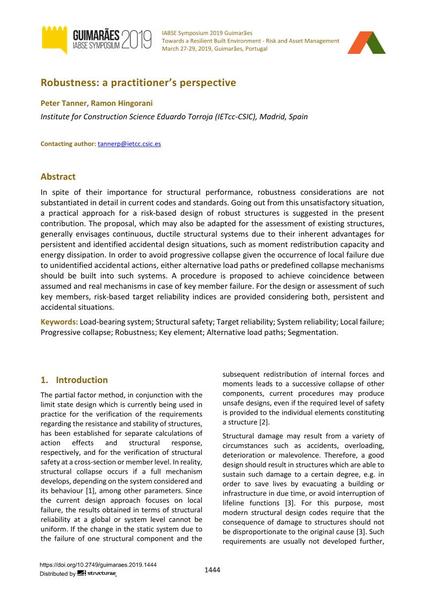Robustness: a practitioner's perspective

|
|
|||||||||||
Bibliografische Angaben
| Autor(en): |
Peter Tanner
Ramón Hingorani (Institute for Construction Science Eduardo Torroja (IETcc-CSIC), Madrid, Spain) |
||||
|---|---|---|---|---|---|
| Medium: | Tagungsbeitrag | ||||
| Sprache(n): | Englisch | ||||
| Tagung: | IABSE Symposium: Towards a Resilient Built Environment Risk and Asset Management, Guimarães, Portugal, 27-29 March 2019 | ||||
| Veröffentlicht in: | IABSE Symposium Guimarães 2019 | ||||
|
|||||
| Seite(n): | 1444-1451 | ||||
| Anzahl der Seiten (im PDF): | 8 | ||||
| DOI: | 10.2749/guimaraes.2019.1444 | ||||
| Abstrakt: |
In spite of their importance for structural performance, robustness considerations are not substantiated in detail in current codes and standards. Going out from this unsatisfactory situation, a practical approach for a risk-based design of robust structures is suggested in the present contribution. The proposal, which may also be adapted for the assessment of existing structures, generally envisages continuous, ductile structural systems due to their inherent advantages for persistent and identified accidental design situations, such as moment redistribution capacity and energy dissipation. In order to avoid progressive collapse given the occurrence of local failure due to unidentified accidental actions, either alternative load paths or predefined collapse mechanisms should be built into such systems. A procedure is proposed to achieve coincidence between assumed and real mechanisms in case of key member failure. For the design or assessment of such key members, risk-based target reliability indices are provided considering both, persistent and accidental situations. |
||||
| Stichwörter: |
Robustheit progressiver Kollaps Tragsicherheit
|
||||
